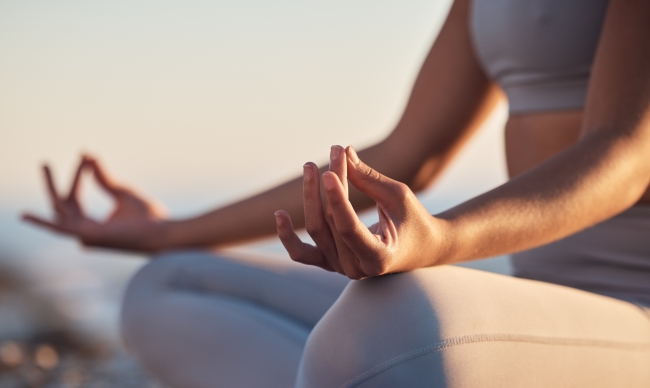You have /5 articles left.
Sign up for a free account or log in.

Almost every Sunday morning, as part of my routine, I try to go to an 8 a.m. yoga class. I enjoy this class because of its flows. We start off slowly, transitioning from the chaos of the everyday lives we have left behind, into the intention and message of the day, and then into our yoga practice. At the end of the practice, we revisit that message and see whether it has resonated with us. And the instructor always lets us know that, if it doesn’t, we are open to providing another message for ourselves as our theme instead.
Something about that consistency in knowing that there will be a message every time I show up to the mat is grounding for me. It sets an expectation as something that I can rely on for when I get there. The theme serves as my road map for the entire practice, guiding me toward my goal of the session. But I appreciate the instructor’s acknowledgement that if the message does not resonate with me on a given day, I am free to develop and affirm my own message.
Last Sunday, I thought about this as I was balancing myself in a pose that’s referred to as the standing split—a pose where a yogi has one foot planted firmly on the ground while the other one is in the air. I couldn’t help but make connections to the name of that pose and the state of how I’m feeling as a staff and faculty member in higher education: I’m still standing, but academe is becoming a more complex and difficult realm to navigate every day. Some days it feels like I might only be standing on one foot and that it is really hard to keep my balance.
More and more, I relate this idea of a standing split to what we are seeing across campuses in higher education: disengagement, anxiety and disconnectedness. Some reasons for that can be attributed to trauma, exhaustion and feelings of hopelessness—among many other reasons. Not only students but also faculty members share those sentiments. In a world where a pandemic and its rippling effects have brought anything but stability and reliability, I find myself noticing the power of the routine practices that keep our feet on the mat every day, even if those practices don’t look the same everywhere.
Such practices can be driven by our own internal needs developed over long periods of time. For a faculty member, it might be grabbing that coffee from the cafe on the way to class to feel more energized and present while teaching in the classroom. For a student, it could be choosing to sit in the same seat in the cafe during their lunch break. For a faculty development specialist like me, the practice might be the planner that we keep, either in person or digitally, that helps us keep track of what we need to do, where we need to be and whom we need to follow up with.
James Clear, an author who writes on habit formation, defines these small practices not as routines, but as atomic habits. Atomic habits are small changes that we can make to the way that we operate on a day-to-day basis that do not individually result in drastic or noticeable differences but when put together can result in transformative change. Over time, these implementations can alter not only our beliefs about ourselves, but also our identities.
We tend to think about routines in relationship to ourselves, but they might provide comfort or assistance to others, as well. As a student, I often used to think that writing the planned activities of a day’s class was meant solely to keep the class organized and our time managed. However, I’ve come to learn in my faculty development research and interviews with students that this type of routine lessens student anxiety and serves as a guidepost for what is next, thus reducing uncertainty for students of what’s ahead.
Lisa M. Nunn, professor of sociology and the director of the Center for Educational Excellence at University of San Diego, speaks extensively of the idea of how certain routines promote belonging on a college campus. Rather than appearing to be busy or engrossed in one’s laptop before class, she encourages that we make it a habit to visibly be unoccupied. This shows students that we are approachable and encourages them to bring us questions that they may have or connect with us in general conversation, thus fostering a greater sense of community.
One routine that I engage in that has both internal and external benefits is holding meetings outside my office—even if the meetings are only with myself. As someone who works in faculty development, I find it helpful for faculty to see me outside my usual four-walled space. Don’t get me wrong—privacy certainly has a time and a place, so this is not always an appropriate setting. But there’s something to be said about speaking about pedagogy over coffee or a delicious meal.
When I step outside my office solo, it often prompts spontaneous conversation and questions from faculty and staff members. Often, they’ve been thinking about emailing me and just haven’t gotten around to it. Being visible and accessible—physically meeting others where they are and making it a point to be around—reminds folks that they have an ally on campus whom they can reach out to.
Others whom I interact with have their own set of routines that help to provide balance and structure or set intention for them. One of my colleagues spends their lunch break walking around the campus. They note to me that they try—weather permitting—to engage in their walk barefoot, as this helps them to feel more connected and grounded to return to the office. Another colleague, upon entering her office, immediately uses essential oils to cleanse the space and tells me that the act of doing it provides her comfort and helps to clear the air before she starts a new day. A third colleague of mine will go to their place of worship before submitting an article, making it a point to pray before hitting the submit button.
In her research on Air & Light & Time & Space: How Successful Academics Write, Helen Sword found that most of the academics she interviewed did not follow standard or recommended practices—rather, the writers who had the most success didn’t follow a prescribed formula but forged their own writing routines. Just as my yoga instructor encourages us to find our own messages, so does Sword encourage us to find the habits that work for us—which may or may not work for others.
What I’ve come to realize is that routine is individual—what works for me to get through my day might be totally opposite of what works for the person next to me. And that’s OK. Individual culture, needs and preferences are what determine these routines for each one of us. My routine is not, and does not need to be, your routine.
As educators, it is impossible for us to know which practices and routines are comforting and helpful for each one of our individual students, but we can work toward a framework where we are open to and expectant of these variations rather than hesitant of them. In a world of standing splits, the way that each of us grounds ourselves might have its own variation, but the most important thing to remember is that we are still showing up to the mat—even if it is just with one foot on the ground.




